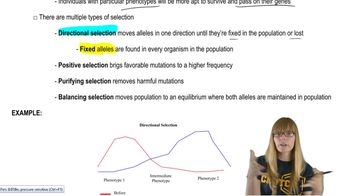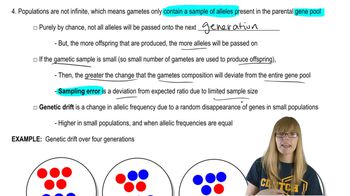Table of contents
- 1. Introduction to Genetics51m
- 2. Mendel's Laws of Inheritance3h 37m
- 3. Extensions to Mendelian Inheritance2h 41m
- 4. Genetic Mapping and Linkage2h 28m
- 5. Genetics of Bacteria and Viruses1h 21m
- 6. Chromosomal Variation1h 48m
- 7. DNA and Chromosome Structure56m
- 8. DNA Replication1h 10m
- 9. Mitosis and Meiosis1h 34m
- 10. Transcription1h 0m
- 11. Translation58m
- 12. Gene Regulation in Prokaryotes1h 19m
- 13. Gene Regulation in Eukaryotes44m
- 14. Genetic Control of Development44m
- 15. Genomes and Genomics1h 50m
- 16. Transposable Elements47m
- 17. Mutation, Repair, and Recombination1h 6m
- 18. Molecular Genetic Tools19m
- 19. Cancer Genetics29m
- 20. Quantitative Genetics1h 26m
- 21. Population Genetics50m
- 22. Evolutionary Genetics29m
17. Mutation, Repair, and Recombination
Types of Mutations
Problem 20c
Textbook Question
Speculate on how improved living conditions and medical care in the developed nations might affect human mutation rates, both neutral and deleterious.
 Verified step by step guidance
Verified step by step guidance1
span>Step 1: Understand the concept of mutation rates. Mutation rates refer to the frequency at which changes in the genetic material occur. These can be neutral, having no effect on fitness, or deleterious, negatively affecting an organism's survival or reproduction.</span
span>Step 2: Consider the impact of improved living conditions. Improved living conditions, such as better nutrition and reduced exposure to environmental mutagens, might reduce the occurrence of mutations by minimizing stress and damage to DNA.</span
span>Step 3: Evaluate the role of medical care. Advanced medical care can lead to the survival of individuals with deleterious mutations, potentially allowing these mutations to persist in the population. However, it can also reduce the impact of these mutations on overall fitness.</span
span>Step 4: Analyze the effect on neutral mutations. Neutral mutations are less likely to be affected by improved living conditions and medical care, as they do not impact an individual's fitness directly. Their rate might remain relatively constant.</span
span>Step 5: Consider the long-term evolutionary implications. Over time, the accumulation of neutral mutations and the persistence of some deleterious mutations due to medical interventions could influence genetic diversity and evolution in human populations.</span
Recommended similar problem, with video answer:
 Verified Solution
Verified SolutionThis video solution was recommended by our tutors as helpful for the problem above
Video duration:
2mPlay a video:
Was this helpful?
Key Concepts
Here are the essential concepts you must grasp in order to answer the question correctly.
Mutation Rates
Mutation rates refer to the frequency at which changes occur in the DNA sequence of an organism. These changes can be spontaneous or induced by environmental factors. Understanding mutation rates is crucial for assessing how genetic diversity and evolution are influenced by external conditions, such as improved living standards and healthcare.
Recommended video:
Guided course

Mutations and Phenotypes
Natural Selection
Natural selection is the process by which certain traits become more or less common in a population due to their impact on survival and reproduction. In developed nations with better living conditions, deleterious mutations may have less impact on survival, potentially allowing them to persist in the gene pool, while neutral mutations may also accumulate without significant consequences.
Recommended video:
Guided course

Natural Selection
Genetic Drift
Genetic drift is the random fluctuation of allele frequencies in a population, which can lead to significant changes over time, especially in small populations. In developed nations, where population sizes are often larger and more stable, the effects of genetic drift may be minimized, allowing for a more consistent mutation rate and potentially altering the balance between neutral and deleterious mutations.
Recommended video:
Guided course

Genetic Drift

 9:49m
9:49mWatch next
Master Point Mutations with a bite sized video explanation from Kylia Goodner
Start learning


